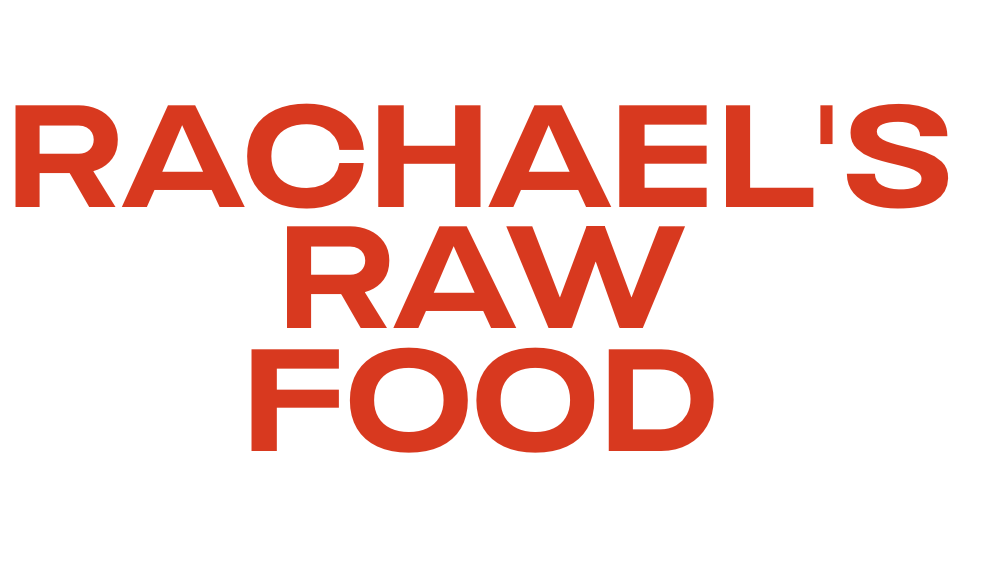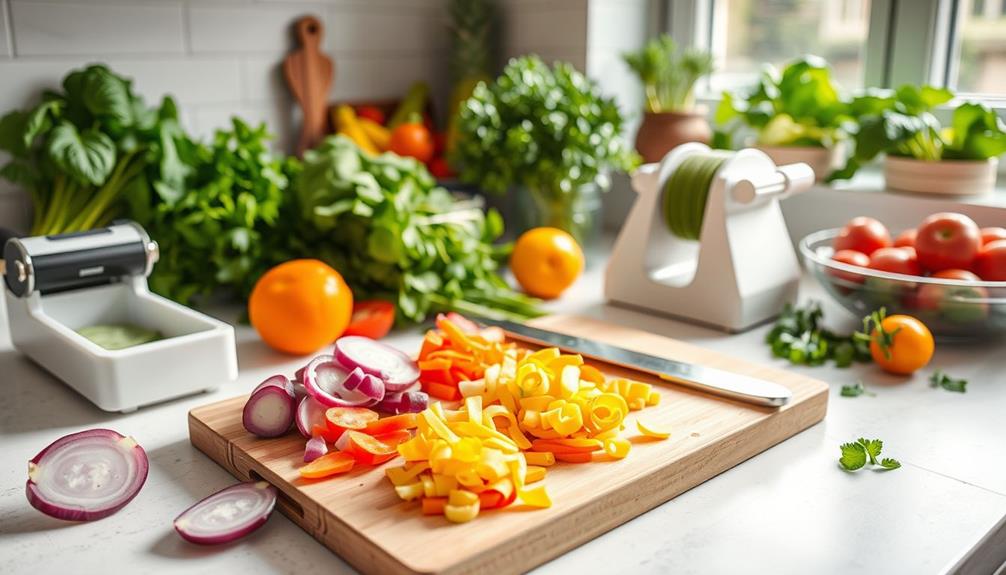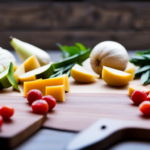To cook raw food effectively, you'll need to focus on a few techniques and fresh ingredients. Start by soaking nuts and seeds overnight to boost digestibility. Use a high-quality blender for smoothies and sauces, and consider a dehydrator to intensify flavors while keeping everything raw. Massaging greens with olive oil and salt changes their texture and enhances taste. Experiment with seasonal produce for the best flavors, and don't shy away from unique vegetables for variety. These fundamental tips can elevate your meals dramatically, and there's plenty more to explore that can refine your raw cooking skills. When it comes to raw cooking, it’s important to remember that heating foods above a certain temperature can destroy their nutritional value. This leads to the common question, “Can raw food be microwaved?” The answer is no; microwaving food goes against the principles of raw cooking. Instead, focus on using techniques like blending, dehydrating, and marinating to bring out the natural flavors of raw ingredients.
Key Takeaways
- Keep raw food temperatures below 118°F to preserve nutrients and enzymes while preparing meals.
- Utilize techniques such as soaking, sprouting, and dehydrating to enhance flavors and digestibility.
- Massaging greens with olive oil and salt improves their texture and flavor for salads.
- Incorporate seasonal produce for maximum freshness, flavor, and nutrient content in your dishes.
- Experiment with unique vegetables and acidic ingredients to elevate flavor complexity in raw meals.
Understanding Raw Food
Understanding raw food begins with recognizing that it mustn't exceed 118°F to retain its essential nutrients and enzymes. When you initiate a raw food diet, the goal is to consume ingredients in their most natural state, ensuring maximum health benefits.
Preparation techniques play a vital role in this process. You can enhance flavor and digestibility by using methods like dehydrating, soaking, sprouting, and low-temperature cooking. Additionally, incorporating ingredients like celery juice can provide high levels of antioxidants and help promote hydration.
Thoughtful planning is key to successfully maintaining a raw food diet. It encourages you to increase your daily intake of fruits and vegetables, which can be both nutritious and delicious.
Engaging with local farmers opens up opportunities to learn about the raw edibility of various vegetables. Their insights might inspire you to get creative in your raw food preparation.
Don't forget to experiment with techniques like massaging greens with olive oil and salt. This simple method can greatly improve the texture and flavor of raw vegetables, making them much more enjoyable to eat.
Sourcing Fresh Ingredients
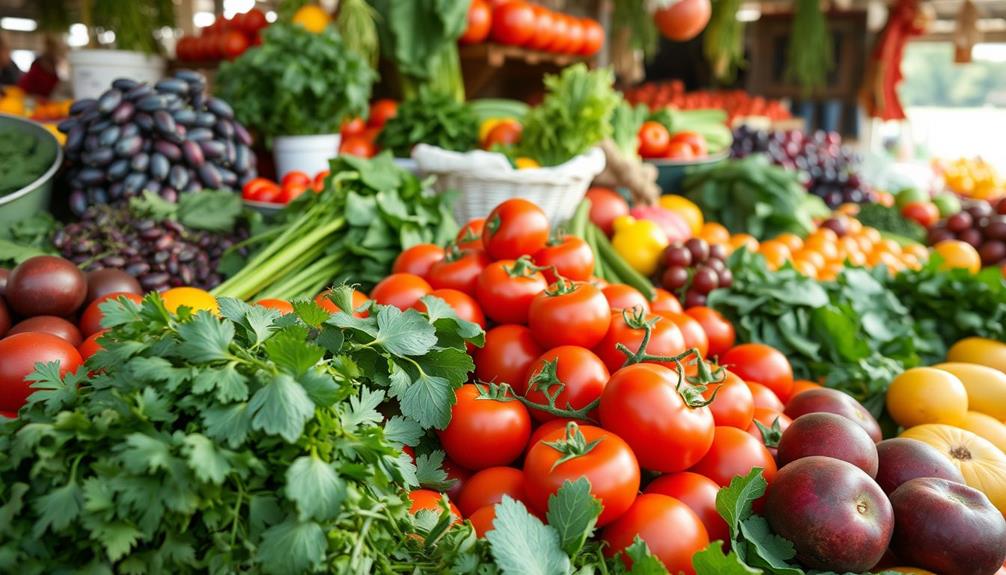
To create delicious raw dishes, you'll want to start by sourcing fresh ingredients from local farmers markets.
These markets not only offer seasonal produce but also allow you to explore unique vegetables that can elevate your meals.
Additionally, consider incorporating elements such as DIY Fire Pit Ideas to enhance your outdoor dining experience and enjoy the ambiance of nature while preparing your dishes.
Finding Local Farmers Markets
Have you ever wondered where to find the freshest ingredients for your raw food creations? Farmers markets are your best bet! These vibrant markets offer a diverse selection of seasonal produce directly from local growers, guaranteeing you get the highest quality ingredients.
Plus, interacting with farmers can provide invaluable insights into which vegetables are raw edible and how to use them effectively. Supporting local farmers also encourages sustainable practices, which can align with your overall financial goals of investing in community and health, similar to the importance of diversification strategy in finance.
Here are some tips for finding farmers markets near you:
- Check local community boards or websites for market schedules.
- Use apps or websites dedicated to locating farmers markets.
- Ask friends or neighbors for recommendations.
- Visit during peak harvest times for the freshest selection.
- Consider joining local food groups on social media for updates.
Shopping at farmers markets not only supports local economies but also encourages sustainable agriculture.
With many markets operating weekly, you can easily plan your shopping trips around fresh offerings, inspiring creativity in your raw meals. By sourcing ingredients from these markets, you'll guarantee your raw food diet is rich in flavor, nutrition, and variety, making your culinary experience enjoyable and fulfilling.
Seasonal Produce Selection
Choosing seasonal produce not only enhances the flavor of your raw meals but also assures you're getting the most nutritious ingredients available. By sourcing fresh ingredients from local farmers markets, you can discover a variety of fruits and vegetables that are often harvested at their peak ripeness. Engaging directly with farmers provides insights into the raw edibility of various veggies, expanding your knowledge of what to include in your dishes.
When you focus on seasonal produce selection, you'll find inspiration to get creative in the kitchen. Experimenting with different flavors and textures can make your raw meals more enjoyable while maximizing nutrient content. Plus, trying out new and unfamiliar vegetables adds excitement and variety to your meals.
Here's a quick look at seasonal produce to reflect on:
| Spring | Summer | Fall |
|---|---|---|
| Asparagus | Tomatoes | Squash |
| Radishes | Bell Peppers | Apples |
| Spinach | Zucchini | Kale |
Choosing local, seasonal produce not only supports community agriculture but also assures your meals are fresh and flavorful. Enjoy the journey of discovering what's in season!
Exploring Unique Vegetables
Diving into the world of unique vegetables opens up a treasure trove of flavors and textures for your raw food creations. Farmers markets are your best bet for sourcing fresh, seasonal produce that includes these intriguing options.
By engaging directly with farmers, you can gain valuable insights about the edibility and preparation of lesser-known vegetables, enhancing your raw food repertoire. Additionally, exploring unique vegetable options can elevate your cooking experience, much like how different brewing methods affect caffeine levels in coffee.
When exploring unique vegetables, consider trying:
- Heirloom tomatoes for vibrant colors and diverse flavors
- Purple carrots that add a pop of color and nutrients
- Romanesco broccoli with its unique fractal shape
- Kohlrabi for a crunchy, invigorating taste
- Fennel for a subtle licorice flavor in salads
These seasonal ingredients inspire creativity in your raw food preparation, ensuring you're using produce at its peak freshness and flavor.
Plus, experimenting with new and unfamiliar vegetables makes your meals more interesting and enjoyable. So, don't hesitate to step outside your comfort zone; exploring unique vegetables can elevate your raw dishes, making them not only more visually appealing but also nutrient-dense.
Happy cooking!
Key Preparation Techniques
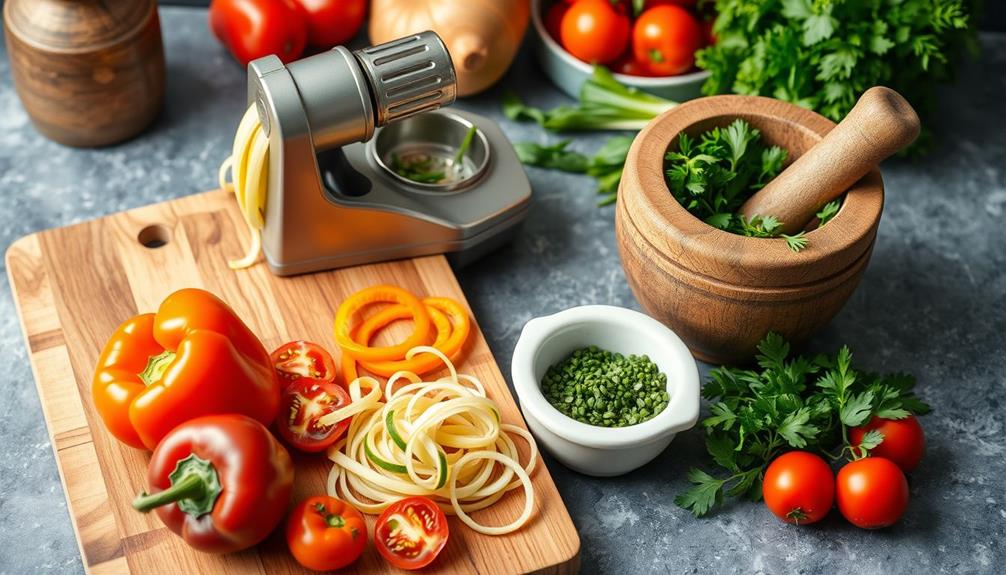
When preparing raw food, incorporating key techniques can greatly enhance the flavors and textures of your dishes. One effective method is soaking seeds, nuts, and grains overnight. This practice boosts digestibility and nutrient absorption, making them easier to incorporate into your raw diet.
Additionally, you can explore the benefits of essential oils for enhancing your overall well-being while preparing meals, as certain oils like lavender can create a calming environment.
Another vital technique is massaging greens with olive oil and salt. Spend at least five minutes doing this to break down the fibers, which improves both flavor and digestibility.
For smoothies, soups, and sauces, using a Vitamix blender is essential; it guarantees a smooth and creamy texture, transforming your raw ingredients into delicious meals.
If you're looking for crispy snacks, consider dehydrating fruits and vegetables. This process intensifies flavors while maintaining the integrity of raw food.
Flavor and Texture Enhancement
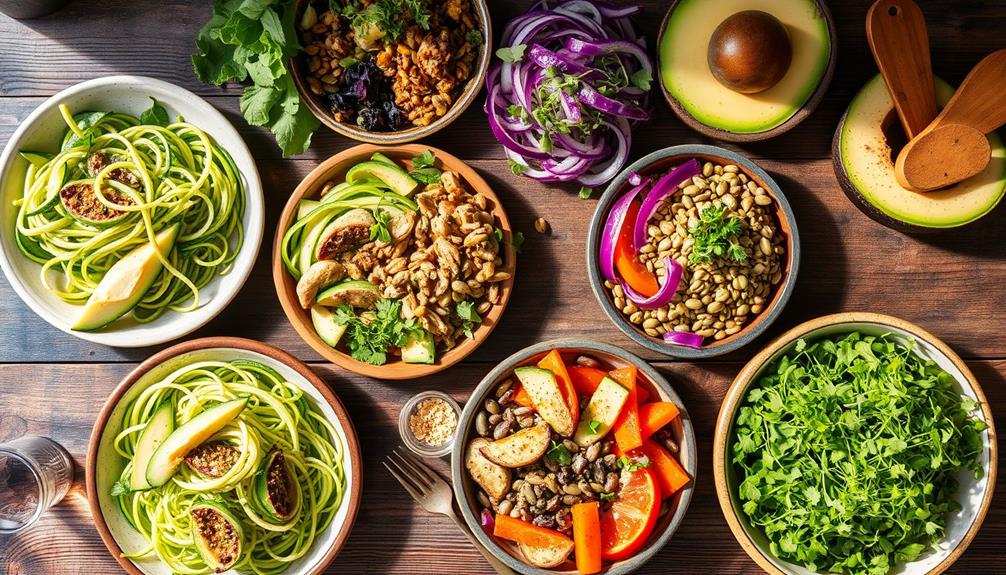
To elevate the flavor and texture of your raw dishes, start by massaging greens with olive oil and salt; this breaks down their fibers and boosts their taste.
Consider incorporating essential oils for flavor enhancement for a unique twist on your dishes.
Don't forget to add acidic elements like lemon juice, which not only brightens flavors but also tenderizes your veggies.
For a creamy touch, consider using cashew cream as a rich, dairy-free dressing alternative that enhances your meals.
Massaging Greens Techniques
Often overlooked, massaging greens is a simple yet effective technique that transforms the flavor and texture of leafy vegetables. By using olive oil and salt, you can break down the fibers in greens, making them more tender and easier to digest.
Properly prepared greens can be as nutritious as a balanced diet for pets, including safe snacks for hamsters, emphasizing the importance of incorporating fresh produce. For ideal results, you should massage the greens for at least five minutes. This time allows the flavors to absorb fully and the texture to improve.
Here are some key points to reflect on when massaging greens:
- Use fresh greens like kale, spinach, or Swiss chard.
- Drizzle olive oil and sprinkle salt before massaging.
- Massage gently, using your fingertips to knead the leaves.
- Allow the greens to marinate for a few minutes after massaging.
- Experiment with different oils and seasonings for varied flavors.
Not only does massaging greens enhance their palatability, but it also encourages you to consume more nutrient-rich vegetables.
Acidic Additions Importance
Acidic additions play an essential role in enhancing the flavor and texture of raw dishes. Ingredients like lemon juice or vinegar balance sweetness and add brightness, making your raw creations more vibrant.
When you incorporate acidic elements, you not only elevate the taste but also help tenderize vegetables, which is vital for emotional reflections on the impact of a mother's love. The acid breaks down fibrous structures, making them more palatable and easier to digest.
Dressing your vegetables with an acidic component in advance allows the flavors to meld, and the acid continues to tenderize the produce over time. This technique is particularly effective for salads, where the inclusion of acidic additions can improve the overall texture.
You'll find that they add a delightful crunch, contrasting beautifully with softer elements.
Don't hesitate to experiment with a variety of acids, such as citrus juices, apple cider vinegar, and balsamic vinegar. Each brings its unique flavor profile, elevating the complexity of your raw food preparations.
Cashew Cream Uses
Cashew cream is a game-changer in raw food preparation, providing a rich, creamy texture that enhances both flavor and mouthfeel.
This versatile, dairy-free alternative can elevate your dishes in countless ways. You can easily make cashew cream by soaking raw cashews for at least four hours, then blending them with water and any desired flavorings like lemon juice or garlic.
Incorporating ingredients like herbs can further amplify the benefits of cashew cream, making it a nutritious addition to your meals that aligns well with a gout-friendly diet.
Consider using cashew cream in the following ways:
- Dressings: Create creamy salad dressings that are rich in flavor.
- Soups: Add it to soups for a luxurious texture without dairy.
- Vegetable Dishes: Mix cashew cream with herbs and spices to complement your veggies.
- Desserts: Sweeten it with vanilla or cocoa for raw cheesecakes and puddings.
- Sauces: Use it as a base for sauces that need a creamy touch.
Essential Tools for Raw Cooking
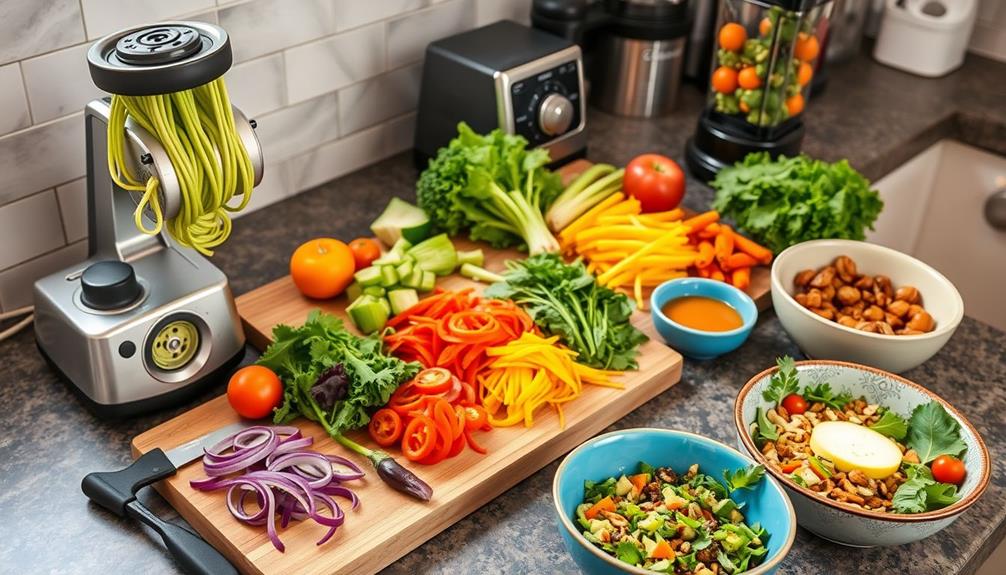
Creating delightful raw meals requires the right tools to access the full potential of fresh ingredients. For raw foodists, a high-quality Vitamix blender is essential. It effortlessly creates smoothies, soups, and sauces, offering versatility that enhances your raw food preparation.
A food dehydrator is another invaluable tool, perfect for making crispy snacks and intensifying the flavors in fruits and vegetables. You can find cost-effective models for under $50, which makes it accessible for anyone.
Spiralizers are fantastic for transforming vegetables like zucchini into noodle substitutes, adding creativity and variety to your dishes. Meanwhile, a food processor is necessary for whipping up raw desserts, snacks, and dips, allowing you to blend and chop ingredients efficiently.
Don't overlook other kitchen gadgets like mandolins and citrus juicers. These tools facilitate creativity and ease in raw meal preparation, helping you produce visually appealing and flavorful dishes.
With the right equipment, you'll unveil a world of culinary possibilities that not only satisfy but also nourish your body. Embrace these essential tools, and elevate your raw cooking game!
Popular Raw Food Snacks

With the right tools in your kitchen, you can easily whip up a variety of delicious raw snacks that are both nutritious and satisfying.
These popular raw vegan food options will keep your taste buds happy while fueling your body with essential nutrients, particularly due to the benefits of raw food that enhance nutrient absorption and energy levels.
Here are some tasty ideas to get you started:
- Dehydrated apple chips: Crunchy and naturally sweet, these chips are free from added sugars and preservatives.
- Kale chips: Seasoned with salt or spices, they're a fantastic alternative to traditional chips, packed with vitamins A, C, and K.
- Raw cookies: Made with medjool dates and nut meals, these sweet treats are high in fiber and healthy fats.
- Raw ice cream: Blend frozen fruits like bananas or mangoes for a creamy, dairy-free dessert that's both delicious and healthy.
- Energy mini bars: Convenient and flavorful, options like mango lime and piña colada combine nuts, seeds, and dried fruits for a quick energy boost.
These raw snacks not only satisfy cravings but also support your health, making them perfect additions to your raw vegan food repertoire!
Creative Raw Food Ideas
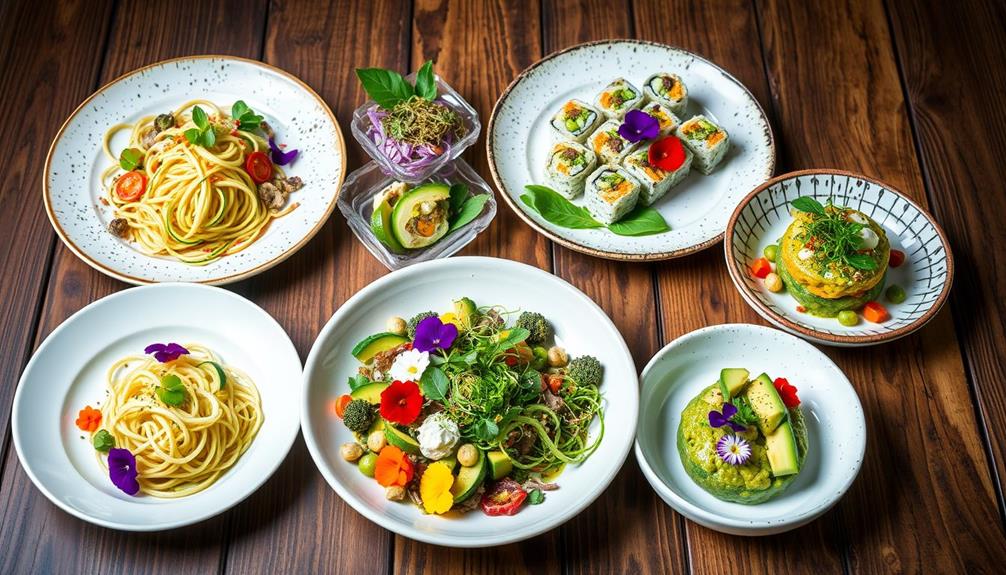
When you're looking to shake up your raw food routine, there are countless creative ideas to explore.
Start by experimenting with a dehydrator to whip up flavorful vegetable chips. You can enhance these snacks with unique seasonings and textures, all while keeping the raw food integrity intact.
Next, grab a spiralizer to transform vegetables like zucchini and carrots into noodle substitutes. This adds variety and creativity to your salads and main dishes, making them more exciting than your usual cooked options.
Don't forget about blending! Mix a combination of fresh, seasonal fruits to craft invigorating smoothies or puddings, ensuring maximum flavor and nutrition.
For a convenient and healthful snack, combine raw ingredients such as nuts, seeds, and dried fruits to create inventive energy bars at home.
Lastly, indulge your sweet tooth with raw desserts. Blend frozen bananas for a creamy ice cream alternative, or use medjool dates and nut meals to whip up delicious raw cookies.
These creative raw food ideas will surely keep your meals vibrant and satisfying, proving that you can enjoy a variety of textures and flavors without cooking.
Transitioning to Raw Foods
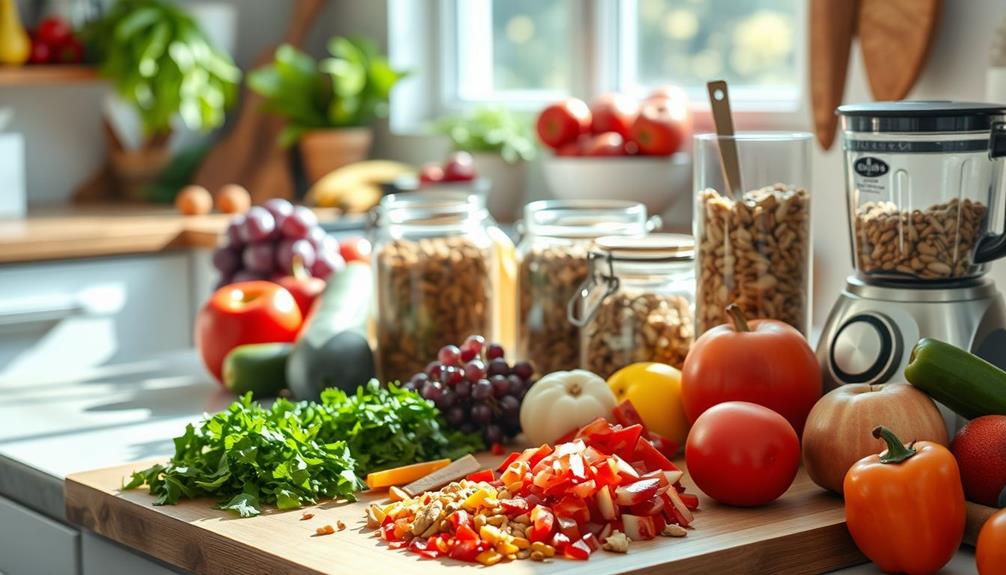
Shifting to raw foods can feel like an exciting journey, but it's important to ease into it gradually. Start by incorporating more raw ingredients into your meals while slowly reducing cooked foods. This lets your body adjust smoothly to the changes.
Here are some tips to help you adapt effectively:
- Focus on seasonal fruits and vegetables for better flavor and nutrition.
- Combine cooked and raw ingredients to aid digestion during the adjustment period.
- Listen to your body; some digestive discomfort might occur as you increase fiber intake from raw foods.
- Experiment with various raw recipes to keep your meals exciting and diverse.
- Join online communities or local raw food groups for support, recipe sharing, and helpful tips.
Taking small steps will make the adjustment more manageable.
Remember, it's all about finding a balance that suits you. As you become more comfortable with raw foods, you'll likely discover new flavors and health benefits that enhance your overall lifestyle.
Frequently Asked Questions
What Are the Techniques of Raw Food?
When exploring raw food techniques, you'll find dehydrating for crispy snacks, soaking to enhance digestibility, sprouting for nutrient activation, low-temperature warming, massaging greens for flavor, and using a Vitamix for easy preparation.
How Do You Prepare Raw Food?
Imagine crafting a vibrant garden on your plate. To prepare raw food, soak nuts overnight, massage greens with olive oil, and add lemon juice for flavor. Planning ahead makes your meals digestible and delightful!
How Do You Prepare Raw Food?
To prepare raw food, you'll want to soak, sprout, and massage greens. Invest time in knife skills for better presentation, and use a high-quality blender for smoothies and sauces to enhance flavor and nutrition. When it comes to raw food protein sources, consider incorporating nuts, seeds, and legumes into your dishes. These can be used to create delicious and satisfying meals, such as nut-based cheeses and spreads or sprouted lentil salads. Experiment with different combinations and flavors to find what works best for you and your dietary needs.
What Is the Process of Raw Food?
Imagine vibrant colors and fresh scents filling your kitchen. You'll explore the raw food process by soaking, blending, and massaging ingredients, ensuring you preserve their nutrients while creating delicious, nutritious meals that excite your palate.
Conclusion
Incorporating raw foods into your diet can be an invigorating change that benefits your health. Did you know that a study found people who eat raw foods consume about 30% fewer calories than those who don't? By understanding the principles of raw cooking and using fresh ingredients, you can create delicious meals that are both nutritious and satisfying. Embrace these tips, get creative, and enjoy the vibrant flavors and textures that raw foods offer!
